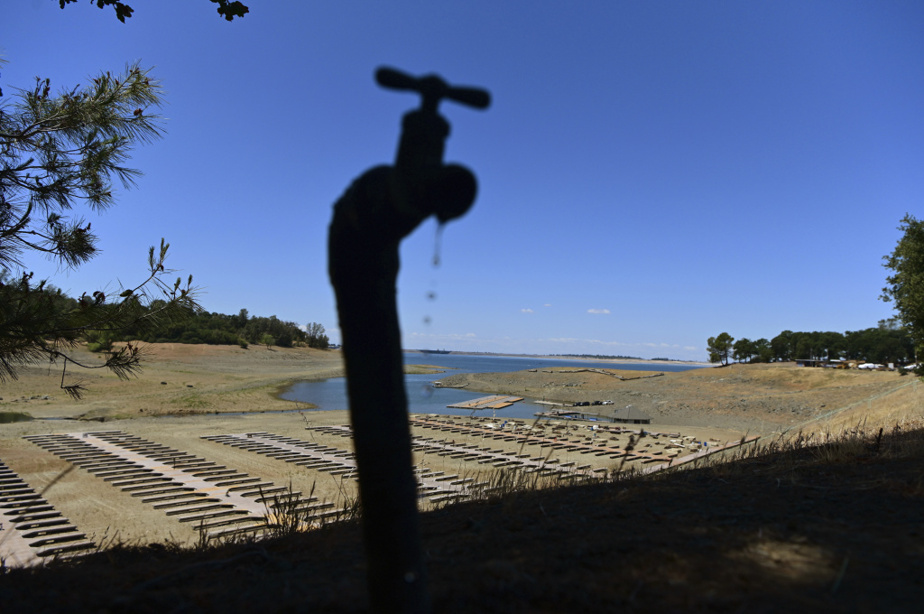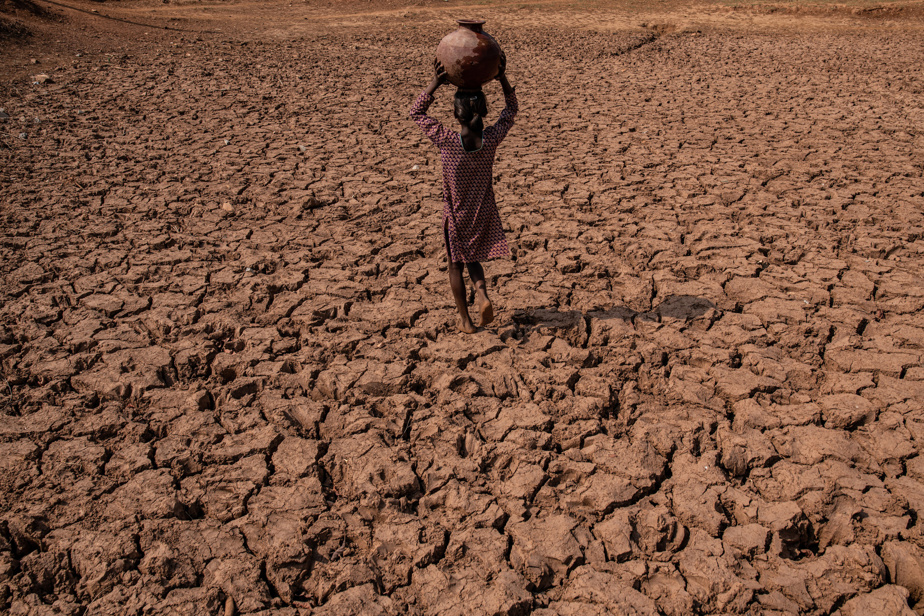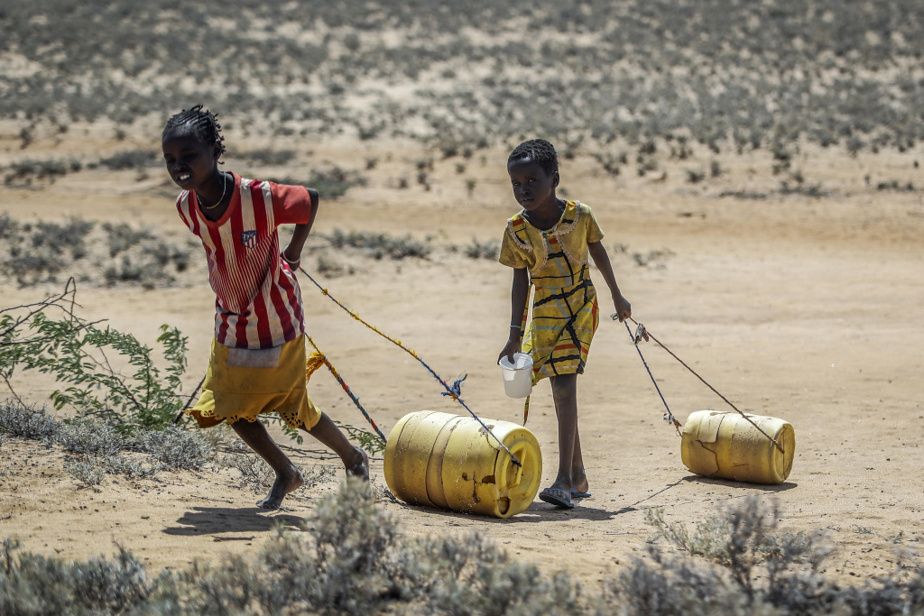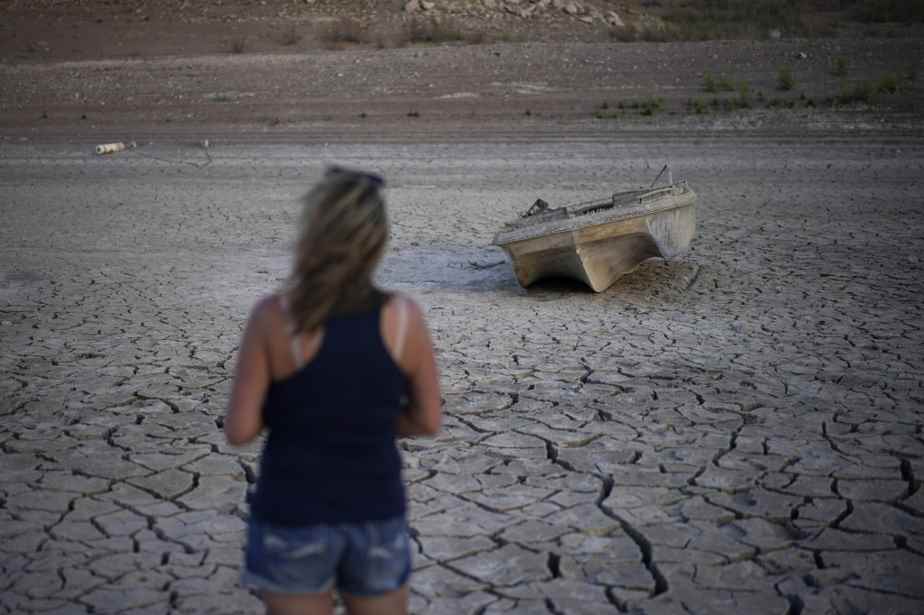Posted at 5:00 a.m.
The four corners of the world under threat
California, United States
Drought now covers nearly 50% of the United States, reports the National Integrated Drought Information System, which tracks drought data across the country. As of May 31, the government agency reported 90 million people affected and more than 170 million acres of farmland disrupted.

Photo Josh Edelson, Associated Press
A faucet is leaking near the boat docks on Lake Folsom in California, a drought-hit state.
California’s water supplies are increasingly becoming a scarce commodity. Indeed, 30% of the population of Southern California is threatened with running out of water while the State Water Project, a public water distribution system, says it will be unable to meet demand in the coming months. In the spring, millions of residents were called upon to reduce their water consumption by 20 to 30%.
France
In France, the drying of the soil is accentuated while Météo France recorded a rainfall deficit of 45% this spring. In 2021, 23 French departments were subject to water consumption restrictions by the Ministry of Ecological Transition. Already twice as many departments are affected by drought this year.

Photo SéBASTIEN BOZON, Agence France-Presse archives
In the summer of 2020, the Doubs in France was at its lowest level in over 100 years.
There are four levels of water restrictions in France: vigilance, alert, heightened alert and crisis. Eight departments are already subject to crisis restrictions which authorize the withdrawal of water only for the purposes of civil security, health, drinking water and sanitation. Water consumption for agriculture is therefore severely restricted, which disrupts harvests. The Ministry of Agriculture and Food Sovereignty has increased allowable spending by water agencies by 100 million euros (approximately C$135 million) to optimize the agricultural sector’s resilience to climate change.
France is not the only country in Europe hit by drought. At the beginning of June, Portugal recorded its hottest May since 1931. The State also confirmed that 97% of the territory was now in a situation of “serious drought”.
India
According to the United Nations, India’s gross domestic product (GDP) has fallen by 2-5% due to the drought that has ravaged the country following extreme heat waves of up to 45.7 ° C in Rajasthan in April, says the Indian Meteorological Service. The State announced on May 13 the suspension of the export of wheat to protect its population against food insecurity.

Photo BRYAN DENTON, The New York Times
The soil in the state of Uttar Pradesh, India, is so dry that it cannot produce enough food for the population.
Since 2010, more than 6,500 people have died due to extreme heat, underlines Agence France-Presse.
India is 30 times more likely to experience extreme heat due to climate change, says the association of scientists World Weather Attribution. May temperatures hit a record high in the north of the country, not seen since 1966, Britain’s National Weather Service, the Met Office, said.
Santiago, Chile
Chile’s capital, Santiago, will for the first time in its history impose a water rationing plan due to low rainfall this year.

Photo IVAN ALVARADO, REUTERS
The Mapocho River, which runs through Santiago, Chile, is nearly dry.
The flow of the Mapocho River, which runs through Santiago, fell by 57% last year, according to official reports. Chile’s Climate and Resilience Research Center has recorded a 30% drop in rainfall nationwide in the past decade.
Horn of Africa
Drought continues to threaten food security in eastern Africa. The number of people suffering from food insecurity jumped by 30% between May and April, from 29 million to 40 million, observes the Intergovernmental Authority on Development.

Photo Brian Inganga, Associated Press
Two girls pull barrels filled with water. Northern Kenya is currently affected by drought.
Never has there been so little rainfall in the Horn of Africa in the past 70 years between the months of March and May, notes the Famine Early Warning Systems Network.
Morocco
North Africa is equally shaken by drought. Morocco’s Ministry of Agriculture records a 35% drop in rainfall since April compared to last year. It is estimated that cereal production will decrease by 69% in 2022. Morocco forecasts favorable conditions for the harvest of fruits and vegetables, but still anticipates a 14% drop in agricultural GDP.

Photo FADEL SENNA, Agence France-Presse
The water is low in the basin of the Abdelmoumen dam, about 60 km from Agadir, Morocco.
With Agence France-Presse
” The situation is serious “
Climate change and ever-increasing population are putting pressure on the world’s water supplies. Countries are now seeking to adapt to this new reality.
Why are droughts more frequent?
The short answer is: because of climate change. “It’s really important to see climate change as a series of extreme events,” says Chris Funk, director of the Climate Hazard Center at the University of California, Santa Barbara. Global climate patterns remain the same, but extreme events are more important.
In California, for example, precipitation in the mountains of Nevada is increasingly raining, says Ellen Bruno, a professor in the department of agriculture and resource management at the University of California. The snowpack that normally accumulated during the winter provided a water supply for the summer. Global warming is reducing natural reservoirs of water, and forcing the region to deplete groundwater, she explains.

PhotoRich Pedroncelli, Associated Press
Watercraft in the drought-lowering waters of Lake Oroville, California
What about our water consumption?
The growing population is increasing the pressure on water everywhere in the world, explains Hossein Bonakdari, assistant professor in the department of soils and food engineering at Laval University. Climate change is forcing society to review its water consumption, as the amount of accessible water turns out to be less than demand during periods of drought.
Again in California, rural areas are very vulnerable to global warming. They are not all supported by an urban water service and depend on natural reservoirs of water that dry up every year, explains Ellen Bruno. The state must then truck drinking water to these communities.
Have we reached a point of no return?
“The situation is serious, we have to be careful,” says Hossein Bonakdari.
Only in Canada, the temperature reached a new record in June 2021, at 49.6°C in British Columbia. In 2018, the equivalent in volume of water of 1.2 million Olympic swimming pools was needed to irrigate agricultural land in the country, a 74% increase in water consumption compared to 2012, notes Statistics Canada. Already a significant portion of the southern Canadian prairies is in “severe drought” and “extreme drought” conditions, according to the Canadian Drought Monitoring Tool (CSW).
“The projections of the models for climate change show that it will increase in the future and especially in the southern Canadian Prairies”, confirms Hossein Bonakdari.
In Africa, the situation is alarming, as poverty makes communities much more vulnerable to climate change, says Linda Ogallo, climate change adaptation expert with the Intergovernmental Authority on Development, Djibouti. While some countries prepare for the worst, others are already suffering the consequences. There must be a common vision to counter droughts, she said.
Is the lack of water likely to create more conflicts?
Yes. In arid areas where water is already scarce, drought increases competition and conflict between these regions, explains Hossein Bonakdari.
And the examples abound. A conflict between Egypt and Ethiopia is currently progressing as an Ethiopian dam is reducing the flow of water in the Nile, it claims. In the Middle East, the Euphrates, which flows through Syria and Iraq, is drying up due to the Ataturk Dam in Turkey. Upstream countries benefit from water control, notes Hossein Bonakdari. “You have to consider all the people downstream to optimize the management of the resource. »
How to adapt to this new reality?
Climate model forecasting technology is a much-needed way to adapt to drought, experts say. Already, some systems predict the temperature of the oceans six to eight months in advance, says Chris Funk. These systems make it possible to act upstream, to meet the needs of the communities and to better manage the risks associated with periods of drought.
“Take for example the amount of energy to heat a pot of water. It takes a lot of energy to heat it. The energy required to warm the ocean is therefore massive. It doesn’t change quickly. We can then predict events with great precision,” he explains.
According to Chris Funk, the ability to warn farmers of upcoming extreme heat in remote parts of Africa would be a great achievement. Forecasting models are mainly developed in Western environments, while the use of data for disadvantaged arid environments is just as necessary, he underlines.
Are the forecasting models adequate?
Although forecasting models are promising, they do not respond to the climate emergency of developing countries, notes Linda Ogallo. Already, communities in Africa are suffering from food insecurity and poverty due to droughts. Climate prediction technology is insufficient to provide vulnerable communities with resilience to climate change, she explains. ” [La sécheresse] is not a problem of tomorrow, but an issue of today. »
“We must stop seeing Africans as a people of vulnerable beggars, but rather as a people who have the potential to make a difference in the world. »

